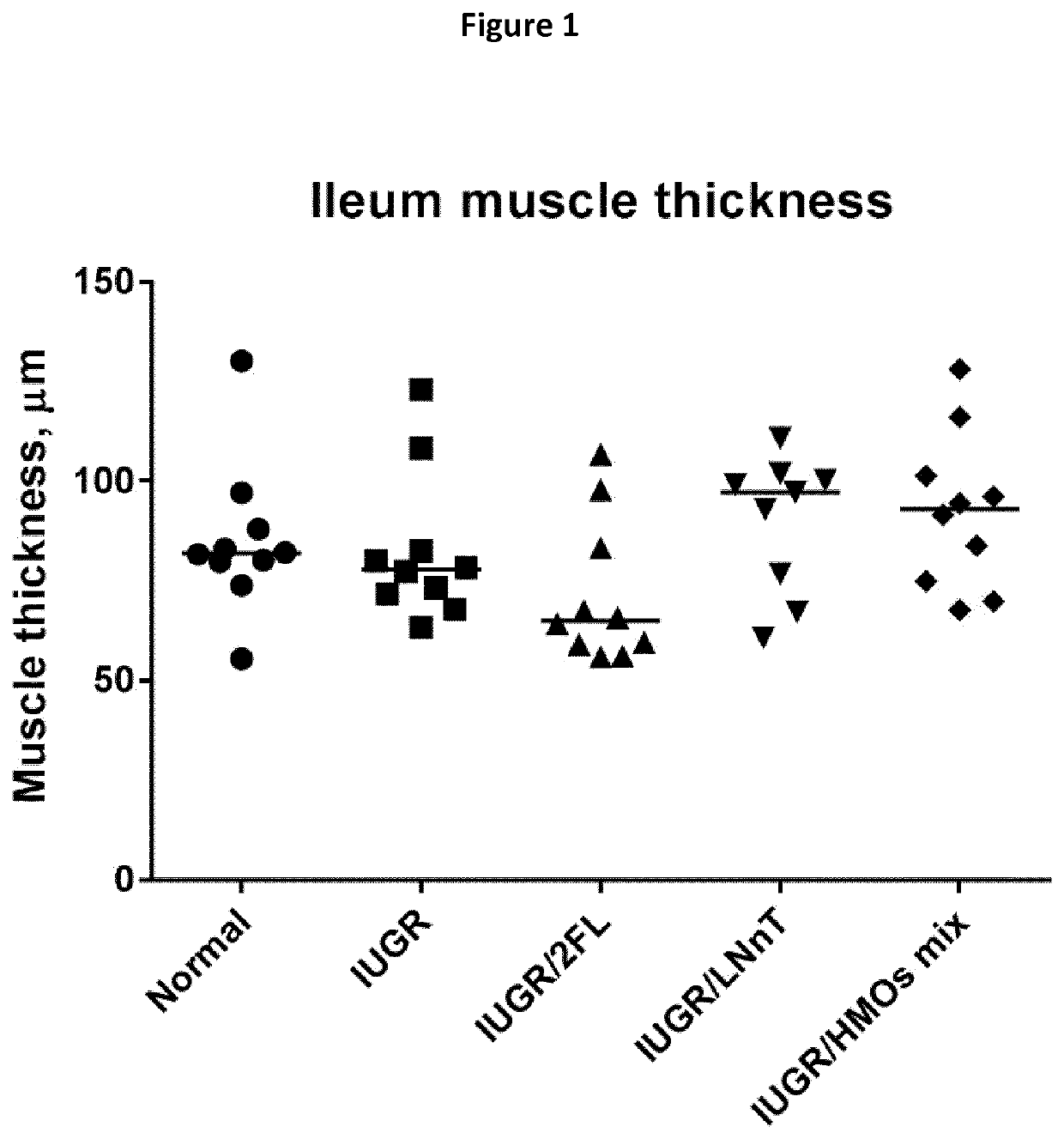Compositions for use in the promotion of intestinal muscle growth and development and associated intestinal motility
a technology for intestinal muscle growth and development, which is applied in the field of nutritional compositions, can solve the problems of impaired intestinal motility, impaired intestinal motility, and impaired motility, and achieve the effects of promoting intestinal muscle growth and/or development, increasing intestinal muscle thickness, and promoting intestinal contractile capacity and intestinal motility
- Summary
- Abstract
- Description
- Claims
- Application Information
AI Technical Summary
Benefits of technology
Problems solved by technology
Method used
Image
Examples
example 1
[0165]An example of the composition of a nutritional composition (e.g. an infant formula) according to the present invention is given in the below table 1. This composition is given by way of illustration only.
TABLE 1Composition of the infant formula of Example 1Nutrientsper 100 kcalper litreEnergy (kcal)100670Protein (g)1.8312.3Fat (g)5.335.7Linoleic acid (g)0.795.3α-Linolenic acid (mg)101675Lactose (g)11.274.7Minerals (g)0.372.5Na (mg)23150K (mg)89590Cl (mg)64430Ca (mg)62410P (mg)31210Mg (mg)750Mn (μg)850Se (μg)213Vitamin A (μg RE)105700Vitamin D (μg)1.510Vitamin E (mg TE)0.85.4Vitamin K1 (μg)854Vitamin C (mg)1067Vitamin B1 (mg)0.070.47Vitamin B2 (mg)0.151.0Niacin (mg)16.7Vitamin B6 (mg)0.0750.50Folic acid (μg)960Pantothenic acid (mg)0.453Vitamin B12 (μg)0.32Biotin (μg)2.215Choline (mg)1067Fe (mg)1.28I (μg)15100Cu (mg)0.060.4Zn (mg)0.755OligosaccharidesLNnT (g)0.0750.5(HMOs)
example 2
[0166]An example of the composition of a nutritional composition (e.g. an infant formula) according to the present invention is given in the below table 2. This composition is given by way of illustration only.
TABLE 2Composition of the infant formula of Example 2Nutrientsper 100 kcalper litreEnergy (kcal)100670Protein (g)1.8312.3Fat (g)5.335.7Linoleic acid (g)0.795.3α-Linolenic acid (mg)101675Lactose (g)11.274.7Minerals (g)0.372.5Na (mg)23150K (mg)89590Cl (mg)64430Ca (mg)62410P (mg)31210Mg (mg)750Mn (μg)850Se (μg)213Vitamin A (μg RE)105700Vitamin D (μg)1.510Vitamin E (mg TE)0.85.4Vitamin K1 (μg)854Vitamin C (mg)1067Vitamin B1 (mg)0.070.47Vitamin B2 (mg)0.151.0Niacin (mg)16.7Vitamin B6 (mg)0.0750.50Folic acid (μg)960Pantothenic acid (mg)0.453Vitamin B12 (μg)0.32Biotin (μg)2.215Choline (mg)1067Fe (mg)1.28I (μg)15100Cu (mg)0.060.4Zn (mg)0.755Oligosaccharides2FL (g)0.151(HMOs)LNnT (g)0.0750.5
example 3
Description of the Study
[0167]Three groups of time-mated pregnant Sprague-Dawley female rats were bought from Charles River laboratories. One group was submitted to food restriction of 60% during the last 10 days of gestation and their offspring were cross-fostered to normally fed rats. A second group of pregnant females was normally fed and their offspring cross-fostered among the same group of dams. Immediately after birth (postnatal day 2 (d=2)), the born rat pups—subjects of the experiment—were assigned to one of the following groups:[0168]Normal group (positive control): Normal-weight offspring born from unrestricted dams and fed after birth a normal non-supplemented diet;[0169]IUGR group (negative control; n=20): IUGR rats being fed a normal diet after birth;[0170]IUGR rats+HMO (test groups): During the experiment, they were reared by their mothers for 21 days and supplemented with HMOs (2-FL, LNnT or the Mix of 2-FL and LNnT). At weaning, they were fed a diet supplemented wit...
PUM
 Login to View More
Login to View More Abstract
Description
Claims
Application Information
 Login to View More
Login to View More - R&D
- Intellectual Property
- Life Sciences
- Materials
- Tech Scout
- Unparalleled Data Quality
- Higher Quality Content
- 60% Fewer Hallucinations
Browse by: Latest US Patents, China's latest patents, Technical Efficacy Thesaurus, Application Domain, Technology Topic, Popular Technical Reports.
© 2025 PatSnap. All rights reserved.Legal|Privacy policy|Modern Slavery Act Transparency Statement|Sitemap|About US| Contact US: help@patsnap.com

